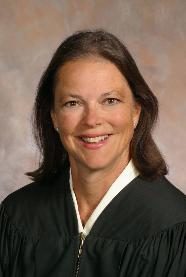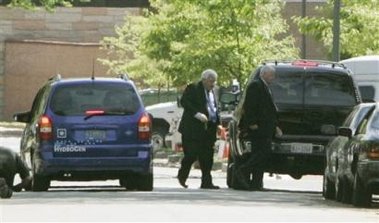Tibbetts article on 17th redistricting
I receieved the following comment on the "17th Monstrosity" post of 5-18-06.
Ed Tibbetts did a great story on this very subject shortly after the district was drawn up. He even went down to Springfield and found the aforementioned alley.
Here is the piece:
Byline: Ed Tibbetts QUAD-CITY TIMES
Source: Quad-City TimesPublication
Date: June 24, 2001Page: A1
SPRINGFIELD -- At the east end of tree-lined Washington Park, midday joggers regularly run by Jennifer Lee's tidy little home on South MacArthur Boulevard. As they pad their way up MacArthur from South Grand Avenue and make the turn down Fayette Avenue, they pass from Illinois newly created 18th Congressional District through the 17th District and then into the 19th.
It takes all of 10 seconds.
Among the oddities of Illinois' new congressional boundaries is a narrow strip of land running through the west side of this capital city of 105,000 people. On either side of the ribbon of property marked by upper- and middle-class homes and a private golf course are the new 18th and 19th districts, represented by U.S. Reps. Ray LaHood and John Shimkus, both Republicans. In between is the new 17th, represented by U.S. Rep. Lane Evans, a Democrat.
Evans, of Rock Island, has long been renowned for his labor and working-class roots in the Quad-Cities. It has been the source of his political strength. But now, with the new boundaries redrawn for use beginning in 2003, he will have a whole new territory to cover. The sprawling, winding district stretches from Rock Falls on the north through the metropolitan Quad-Cities down the Mississippi River to rural Calhoun County -- about an hour north of St. Louis -- then all the way east to encompass parts of Springfield. Eventually, it travels along U.S. 72 to Decatur, 180 miles from Evans' home.
"If you look at it, it's insane," Lee, a 24-year-old homemaker, says with a laugh. "It's obviously not right."
Republicans agree, but they're not laughing.
"I was livid," says Terry Weitzel of Peoria, who worked for the Rock Island County Republican Party last year against Evans. "It's added a good 5 to 6 percent to the Democratic numbers, which will make it virtually impossible for a Republican to win. Usually, I'm an optimistic person, but I don't think this is doable."
The new maps were drawn up under the control of House Speaker Dennis Hastert, a Republican from Yorkville who now picks up part of Henry County in his district, and Rep. Bill Lipinski, a Chicago Democrat. The dynamic driving the process was the shift in population throughout the state over the past 10 years.
Illinois' map is remarkable for this fact: Each district contains exactly the same amount of people, 653,647. However, its odd shape has prompted editorial discontent and a legal challenge from a group of downstate residents, including a Democratic congressman who was thrown into a heavily Republican district. For Evans, though, the new territory, while politically more friendly, represents a logistical challenge in that it now touches upon 23 counties. Previously, he had to deal with 14.
Much of the rural farm country in northwest Illinois has been traded for a strip of land leading down the east side of the Mississippi River and a mixture of farmland and urban neighborhoods that stretch across central Illinois. Rock Island County is still the largest urban center in the district, but there is a sizable population in the new district that lives on the east side of Springfield and throughout Decatur.
Some believe that while the district contains more Democrats, it will be flavored with more moderate Democrats. "It's definitely got southern roots, a more southern attitude," says Don Johnston, who represents the 17th Congressional District on the Illinois Democratic Party Central Committee.
One of those southern counties is Calhoun, a peninsula bounded on the east, west and south by the Mississippi and Illinois rivers. It is a small county of 5,000 people, where crossing into Missouri for most people means taking one of four ferries. People there are wondering how Evans will represent them.
"We just wonder how someone that far away can know about our needs," says Rose Stumpf, the chairman of the county Republican Party.
It's a question that comes up frequently for Evans' political director, Jeremiah Posedel, as he puts hundreds of miles on his car taking in the new district. " 'How often are we going to see him?' is the first question I usually get asked," he says.
Nonetheless, some of the issues that face Calhoun County are the same as in Rock Island County. Transportation is a big one. Most people commute to work, often to St. Louis. Driving, instead of taking a ferry across the Mississippi River, means going all the way to the northern part of the county.
Low crop prices have hurt the farm economy there, just as they have elsewhere in the Midwest.
"Farmers are almost extinct here," Stumpf says.
Next week, Evans plans a three-day tour of the new district to introduce himself, including a stop in the Calhoun County seat of Hardin. In the meantime, "our staff has really been working it," Posedel said.
Among the things he tells people afraid of being represented by a congressman who lives so far away is this: "I'd rather have Lane Evans represent me and live 500 miles away than have a Republican who lives next door."
In the new district, it's a message that probably sells well. Tom Getz, the chairman of the Republican Party in Rock Island County, sounds pessimistic about the chances of mounting a viable challenge to Evans next year. Getz says he's not giving up, but adds, "I think we've just got to accept our fate at this point."
Since the new congressional districts were signed into law by Gov. George Ryan last month, they have been roundly criticized by newspaper editorial writers. And they have been challenged by a group of downstate people, led by U.S. Rep. David Phelps, a Democrat from Eldorado, which is in the southeastern part of the state. The new map places him in a predominantly Republican district with incumbent U.S. Rep. Tim Johnson, a Republican.
The suit, filed in a state court in southeastern Saline County, charges that the map violates the Illinois Constitution and is the "product of political gerrymandering and/or collusive bipartisan gerrymandering."
The district that includes Phelps skirts down the eastern part of the state before turning, comma-like, to include part of Saline County, Phelps' home. "The line was drawn two blocks from his house," said his spokesman, Rob Griner.
The state has not yet filed a response to the lawsuit.




































